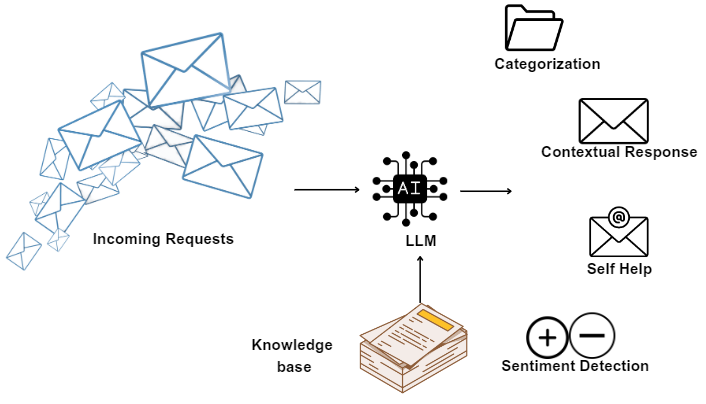
5 Use Cases to Leverage Large Language Models in Customer Service Interactions
Last Updated on May 25, 2023 by Editorial Team
Author(s): Sriram Parthasarathy
Originally published on Towards AI.

Customer service is the lifeblood of any successful business. Excellent customer service fosters customer loyalty, strengthens relationships, and boosts a brand’s reputation. Yet, with a huge volume of customer inquiries in the digital age, providing prompt and personalized responses can be a challenge. This is where Large Language Model (LLM) can help.
Large Language Models can improve customer service operations, making them more efficient, accurate, and personalized. From contextual response generation to sentiment detection, LLMs can offer significant benefits in handling customer interactions. I will walk through few examples and benefits of using LLM for customer service operation.
What is a Large Language Model
Imagine a large language model (LLM) as a highly intelligent AI assistant that specializes in understanding and processing human language. To become such an adept language processor, the LLM underwent extensive training on massive volumes of text data. During this training process, it learned intricate patterns, grammar rules, and the meaning behind words and sentences. Consequently, it gained the remarkable ability to generate responses that are not only coherent but also contextually appropriate.
LLMs excel at a variety of language-related tasks. For instance, they can comprehend and interpret natural language, generate text that resembles human writing, translate languages, summarize lengthy texts, and perform many other language-centric activities. A prime example of a powerful LLM is OpenAI’s GPT-3, which has been meticulously trained on extensive datasets. As a result, it possesses the remarkable capacity to comprehend and generate text that is strikingly similar to what a human would produce. It can effortlessly tackle a wide range of subjects and adapt to various contexts.
In the next few sections, we will discuss how large language models can be helpful in Optimizing Customer Service interactions.
1. Contextual Response Generation
Lets take an example of a customer who has previously contacted your support team regarding a specific product issue. When they reach out again, wouldn’t it be fantastic if your support team could instantly recall all prior interactions and respond keeping in to account all the past conversation context?
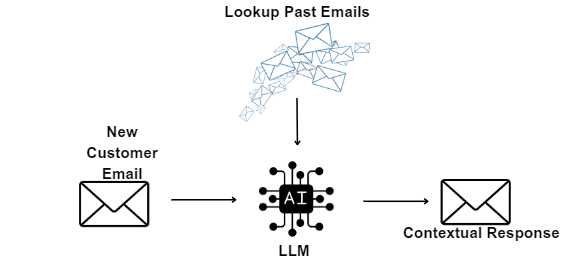
By analyzing a customer’s previous interactions, LLMs can generate personalized responses to the customer’s request. For instance, if a discount was promised to the customer in a prior email, this context is read and incorporated in the response back to the customer
2. Triage and Categorization
A vital part of customer service is managing and sorting incoming customer emails and forward it to the right department to follow through. LLMs can help analyze these emails, automatically categorizing them based on content, which might range from “Technical Support” to “Billing Inquiries”. If a customer emails about a “billing error”, the LLM identifies the email, categorizes the email under “Billing Inquiry”, and even assigns a priority level based on predefined criteria for the right department to act upon. This helps streamline the support process, enabling agents to address critical or time-sensitive inquiries promptly.
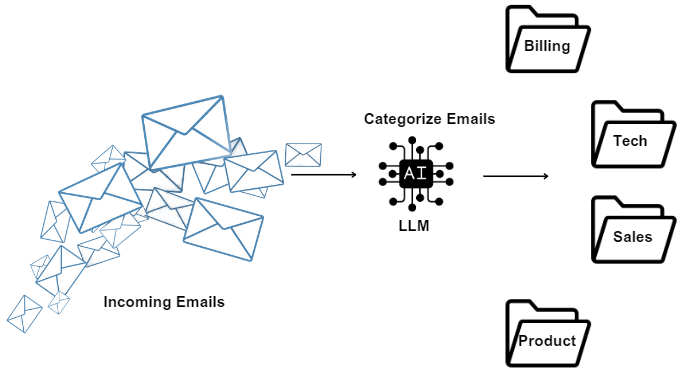
This article talks about how to build out domain-specific models for your use cases.
3. Quick automated self-help responses
Let’s say a customer sends an email requesting guidance on account setup. Say this is a well understood problem and can be handled automatically. Here, LLMs can generate comprehensive instructions tailored to the specific situation. They can include step-by-step guidelines and relevant links and even anticipate common follow-up questions or concerns, ensuring the customer receives a thorough response to their inquiry.
While the LLM can generate a draft response, its important to realize that human review, and customization remain critical. Support agents can add a personal touch, ensuring the response aligns perfectly with the customer’s specific needs and circumstances.
4. Knowledge Base Integration
Most companies have a knowledge base of questions and answers that has been answered before which is a good source to tap in to. But what if your customer service could go a step further and directly provide customers with the most relevant articles or resources from your knowledge base?
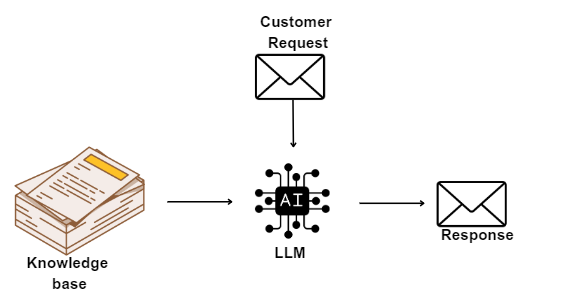
When a customer emails about a specific product issue, the LLM can analyze the customer’s query, search the company’s knowledge base for relevant articles, and provide a summary or excerpt of the article directly in the response. Not only does this empower customers to resolve their issues independently, but it also promotes self-service options and ensures that the most up-to-date information is readily available.
This article walks through how to integrate your private documents with LLMs.
5. Sentiment Detection and Emotion Recognition
The ability to understand a customer’s sentiment or emotion can significantly enhance the way businesses respond to inquiries. LLMs can analyze customer emails for sentiment detection, sarcasm detection, and emotion recognition.
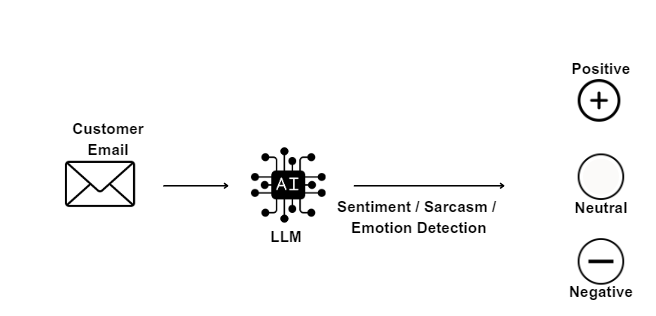
This means that whether a customer’s tone is positive, negative, or neutral, or if it contains elements of sarcasm, the LLM can detect these nuances. It can even recognize and interpret emotions such as anger, frustration, or happiness, allowing businesses to prioritize responses, escalate urgent cases, and provide empathetic support tailored to the customer’s emotional state. Empathizing with the customer and correctly responding to them based on customer’s state of mind will go a long way to help nurture customer relationship.
Conclusion
In today’s subscription driven environment, customer is the king. Meeting customer expectations is very important to thrive in a competitive landscape. Companies are looking for ways to augment traditional approaches and help forge meaningful and personalized connections with their customers.
LLMs has the potential to enable businesses to offer personalized experiences by generating contextually relevant responses. They can take in to account the past conversations as well as customers sentiment and provide tailored and empathetic response, providing a sense of personalized attention.
For instance, imagine a customer who contacts a company’s support team expressing disappointment with a recent service disruption. Through sentiment analysis, an LLM can detect the negative sentiment, lookup any past conversations and generate a response that acknowledges and empathizes with the customer’s frustration. This personalized and empathetic approach can help restore trust and loyalty in the customer, strengthening the brand-customer relationship. Note that a human review of the response generated is critical.
In conclusion, incorporating LLMs into customer service operations allows businesses to augment conventional approaches, delivering personalized, efficient, and empathetic experiences. Companies have the opportunity to revolutionize their customer service operations, elevate the overall customer experience, and cultivate satisfied customers who become invaluable brand ambassadors.
Join thousands of data leaders on the AI newsletter. Join over 80,000 subscribers and keep up to date with the latest developments in AI. From research to projects and ideas. If you are building an AI startup, an AI-related product, or a service, we invite you to consider becoming a sponsor.
Published via Towards AI














